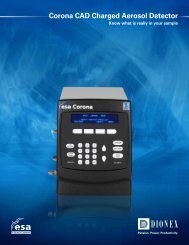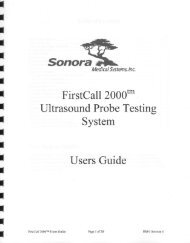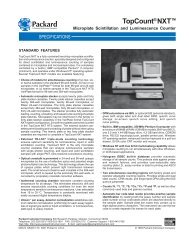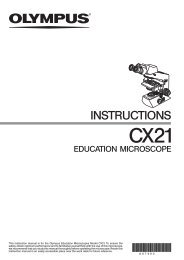HR-33T Dew Point Microvoltmeter Instruction/Service Manual ...
HR-33T Dew Point Microvoltmeter Instruction/Service Manual ...
HR-33T Dew Point Microvoltmeter Instruction/Service Manual ...
You also want an ePaper? Increase the reach of your titles
YUMPU automatically turns print PDFs into web optimized ePapers that Google loves.
SECTION 5 – ELECTRONICSThe electronic system of the <strong>HR</strong>-<strong>33T</strong>, when in the DEW POINT operational mode, is depicted in the blockdiagram, Figure 5. The voltage signal from the thermocouple is processed through the microvoltmeter section ofthe instrument, amplified by a gain of 10. This signal is fed to the panel meter through the range amplifier andinto the non-inverting input of a level comparison circuit whose bistable logic output is either “high” (positive)or “low” (negative) depending upon whether the voltage at the + input terminal is higher or lower than the voltageat the – input terminal. The microvoltmeter signal is compared to the sawtooth ramp voltage by this circuit. Sincethe ramp voltage starts at zero, and assuming that some finite signal is present from the thermocouple(thermocouple temperature depressed from ambient), the comparator output will initially be “high,” and thethermocouple will receive cooling current through the electronic switching circuits. When the ramp voltagebecomes higher than the signal voltage, the output of the comparator switches to “low,” and the cooling currentis discontinued. The microvoltmeter indicates the thermocouple voltage during this interval, and the sample holdcircuit maintains the signal level from one reading interval to the next. The negative pulses produced by thesawtooth/pulse generator circuit are added to the thermocouple signal at the + input of the comparator. Thesepulses represent a 0.05 duty cycle, and limit the cooling duty cycle to a maximum of 0.95, ensuring a minimumread interval of at least 0.05 to maintain the output signal in the sample hold circuit.The height of the sawtooth waveform is adjusted by the A v SET control such that for a given thermocouple, thecooling duty cycle, as dictated by the thermocouple temperature depression signal, will remove precisely thatamount of heat that is flowing into the junction from its surroundings. If the water on the junction then causesa movement of the junction temperature toward the dew point, the output signal will change, dictating acorresponding change in the cooling duty cycle, thus maintaining a balance of thermal energy being conductedinto and out of the junction.To further illustrate, Figure 6 depicts the temporal relationship between the various signal and control waveformsand levels as they will appear during initial cooling and as the junction temperature converges to the dew point.The height of the sawtooth waveform is determined by the A v SET control to match the thermocouple coolingcoefficient, A v . For another junction having a different cooling coefficient, a different sawtooth height willaccordingly be set in the instrument.At output levels below approximately 0.75 µvolts (-1 bar), the cooling duty cycle becomes so small that thefrequency response characteristics of the processing circuitry begin to affect the linearity of the system, such thatautomatic dew point operation cannot be maintained in this range.25
















